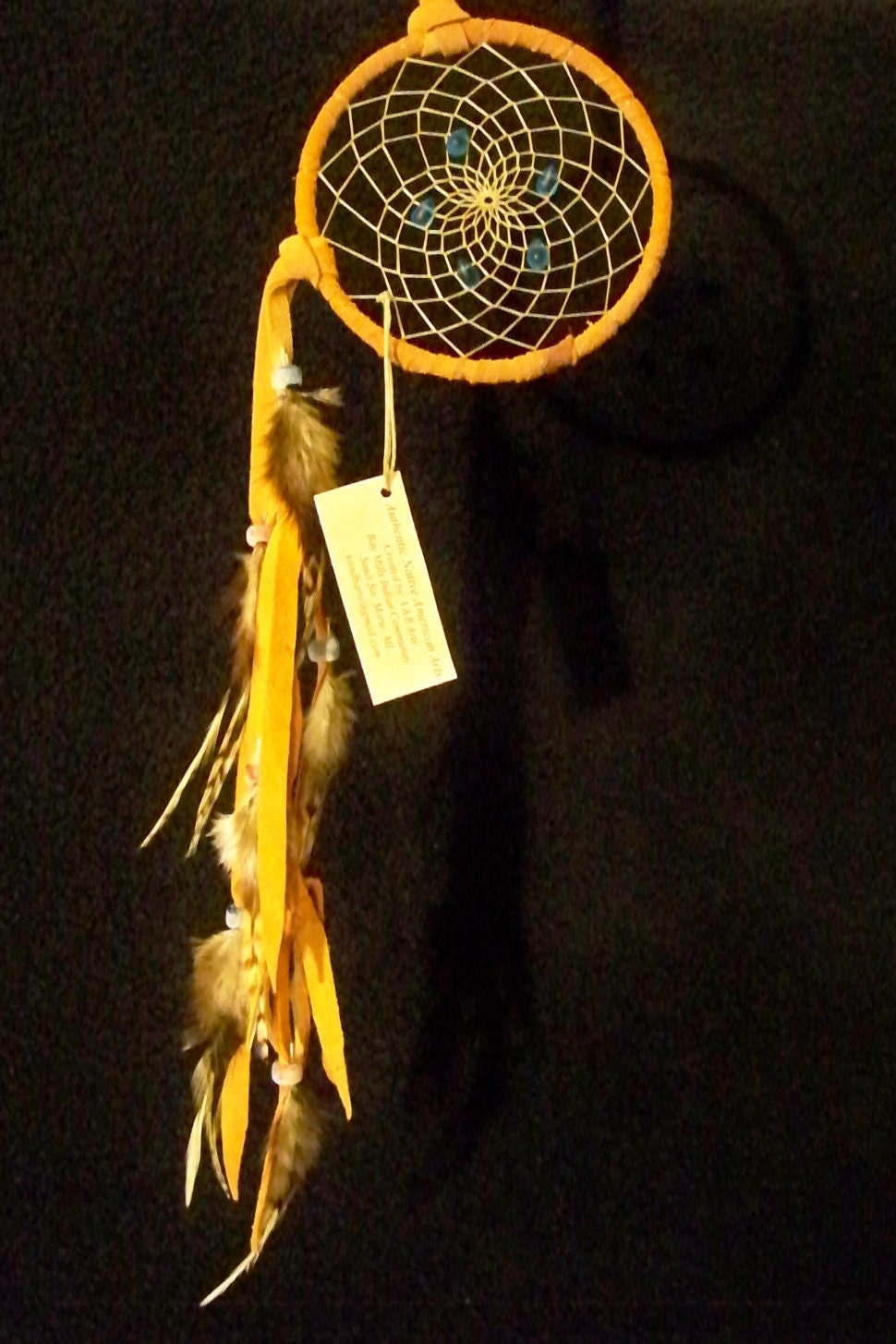Authentic Ojibwe Dream Catcher
- Many Ojibwe lodges had a dream catcher hanging above the family’s sleeping area in order to filter bad spirits from all of their dreams. As intermarriage and trade contact with other tribes increased, the concept of dream catchers spread to nearby tribes such as the Lakota who, over time, developed their own traditions.
- Handcrafted by Northern Minnesota White Earth Ojibwe Indians (the original makers of a DreamCatcher), is this twig and sinew dream catcher with prayer feather and seed bead spider. Each is one of a kind, Authentic and guaranteed to be original. Measure between 2 1/2″ to 3″ in diameter. Styles will of course vary – colored.
Dreamcatchers are an authentic American Indian tradition, from the Ojibway (Chippewa) tribe. Ojibway people would tie sinew strands in a web around a small round or tear-shaped frame-in a somewhat similar pattern to how they tied webbing for their snowshoes-and hang this 'dream-catcher' as a charm to protect sleeping children from nightmares. When dreamcatchers were originally made, the Ojibwe people used willow hoops and sinew or cordage made from plants. The shape of the dreamcatcher is a circle because it represents how giizis – the sun, moon, month – travel each day across the sky.
If dreamcatchers protect children from nightmares, Carol Edwards is ensuring that all the kids in Tuolumne County have sweet dreams. Edwards, 52, of Sonora, is hoping her dreamcatcher — 28.3 feet in circumference and 9 feet in diameter — will make the pages of the “Guinness Book of World Records.” If you are interested you can write the article author at rhowes@uniondemcrat.com
Indian Dream Catchers
ANDRÉ'S NOTEI am an enrolled member of the Karuk Tribe. We do not make dreamcatchers. This woman is guilty of cultural appropriation.Authentic Ojibwe Dream Catcher


Authentic Ojibwe Dream Catchers
Long ago in the ancient world of the Ojibwe Nation, the Clans were all located in one general area of that place known as Turtle Island. This is the way that the old Ojibwe storytellers say how Asibikaashi (Spider Woman) helped Wanabozhoo bring giizis (sun) back to the people. To this day, Asibikaashi will build her special lodge before dawn. If you are awake at dawn, as you should be, look for her lodge and you will see this miracle of how she captured the sunrise as the light sparkles on the dew which is gathered there.

Asibikaasi took care of her children, the people of the land, and she continues to do so to this day. When the Ojibwe Nation dispersed to the four corners of North America, to fill a prophecy, Asibikaashi had a difficult time making her journey to all those cradle boards, so the mothers, sisters, & Nokomis (grandmothers) took up the practice of weaving the magical webs for the new babies using willow hoops and sinew or cordage made from plants. It is in the shape of a circle to represent how giizis travels each day across the sky. The dream catcher will filter out all the bad bawedjigewin (dreams) & allow only good thoughts to enter into our minds when we are just abinooji. You will see a small hole in the center of each dream catcher where those good bawadjige may come through. With the first rays of sunlight, the bad dreams would perish. When we see little asibikaashi, we should not fear her, but instead respect and protect her. In honor of their origin, the number of points where the web connected to the hoop numbered 8 for Spider Woman’s eight legs or 7 for the Seven Prophecies.
It was traditional to put a feather in the center of the dream catcher; it means breath, or air. It is essential for life. A baby watching the air playing with the feather on her cradleboard was entertained while also being given a lesson on the importance of good air. This lesson comes forward in the way that the feather of the owl is kept for wisdom (a woman’s feather) & the eagle feather is kept for courage (a man’s feather). This is not to say that the use of each is restricted by gender, but that to use the feather each is aware of the gender properties she/he is invoking. (Indian people, in general, are very specific about gender roles and identity.) The use of gem stones, as we do in the ones we make for sale, is not something that was done by the old ones. Government laws have forbidden the sale of feathers from our sacred birds, so using four gem stones, to represent the four directions, and the stones used by western nations were substituted by us. The woven dream catchers of adults do not use feathers.
Dream catchers made of willow and sinew are for children, and they are not meant to last. Eventually the willow dries out and the tension of the sinew collapses the dream catcher. That’s supposed to happen. It belies the temporary-ness of youth. Adults should use dream catchers of woven fiber which is made up to reflect their adult “dreams.” It is also customary in many parts of Canada and the Northeastern U.S. to have the dream catchers be a tear-drop/snow shoe shape.